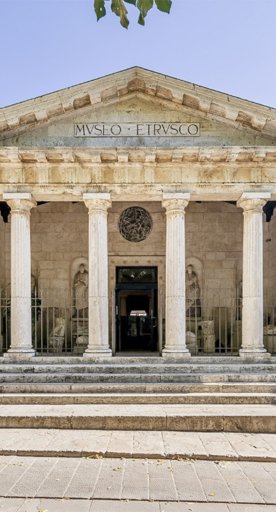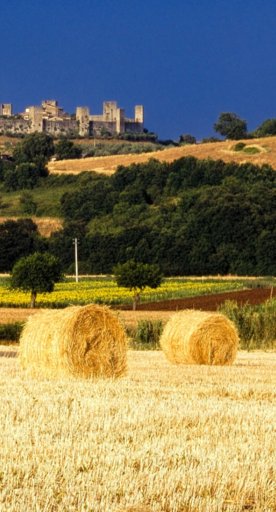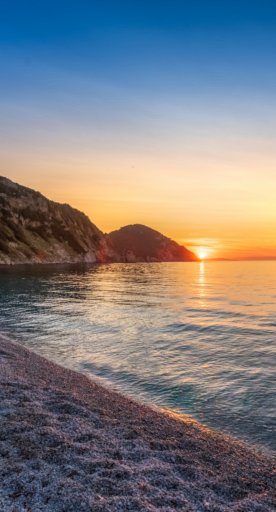
Medieval villages along the Etruscan Coast
From Castagneto Carducci to Piombino: discover the historic cities overlooking the sea
The Tuscan Etruscan Coast is paradise on earth. Here, wild nature and fairytale-like views dazzle visitors. The beauty of this area, however, does not end once summer is over. A little less known, a little less crowded, but no less important than the cultural and historical wealth of the Etruscans, are the fascinating medieval villages.
-
1.Castagneto Carducci and Bolgheri
-
2.Castiglioncello and Rosignano Marittimo
-
3.Suvereto
-
4.Populonia
-
5.Campiglia Marittima
-
6.Sassetta
-
7.Bibbona
-
8.Piombino
-
9.Other villages along the coast
Castagneto Carducci and Bolgheri

Castagneto Carducci sits on the top of the hill, dominated by the Castello dei Conti della Gherardesca which, along with the church of San Lorenzo, forms the original center of the village. Visitors find themselves immersed in a magical atmosphere strolling through streets, alleys and squares. From the central Piazza del Popolo, look out onto the Belvedere Terrace, where a breathtaking panorama awaits you.
At the foot of Castagneto Carducci, you can find San Guido that marks the beginning of the famous Viale dei Cipressi made known by the words of the poet Carducci and which leads to Bolgheri. This romantic avenue is considered a national monument, together with the cemetery where the poet's grandmother, Nonna Lucia, is buried. The timeless Bolgheri Castle is particularly noteworthy.
Castiglioncello and Rosignano Marittimo

Castiglioncello is known as the pearl of the Tyrrhenian for its enchanting bays and crystal clear sea. It has inspired many artists such as the Macchiaioli who gave birth to the Castiglioncello school, as well as being chosen by noted figures from cinema as their place of relaxation. The art, culture and park of Pasquini Castle are simply marvellous. Don't miss the imposing Medici Tower, from which you can enjoy one of the most beautiful views of the Tyrrhenian coast.
Rosignano Marittimo is a delightful medieval village with a magnificent castle vaunting two towers, one of which was once used as a prison and the other as a terrace of the Archbishop's farm. An important archaeological museum is located in Rosignano Marittimo.
Suvereto

Nestled in between the hills and sea of the Etruscan Coast, the characteristic medieval streets of Suvereto glimmer. The historic and culturally rich village is still surrounded by ancient walls. The area "guarded" by the Rocca Aldobrandesca is filled with scents of the Mediterranean scrub. It's also known for its excellent food and wine products, such as oil and wine. In fact, the Wine Road passes here, a route that allows you to explore, step by step, the places where the flavors of the tradition are born.
Populonia

Populonia, in addition to an intriguing archaeological park and characteristic streets from the 1300s, it also preserves 14th-century walls built for defense against barbaric pirates. From the Rocca, which can be visited, you have an exceptional view of the Tuscan Archipelago and the land below.
Campiglia Marittima

The village of Campiglia Marittima is one of the most fascinating in the Val di Cornia; almost suspended between sky and sea, its historic center is still enclosed by the ancient defensive walls and is a succession of narrow alleys, churches, squares and panoramic views.
The upper part is dominated by the Rocca di Campiglia, which together with the Palazzo Pretorio, is one of the main attractions of the village. The earliest written records take us back to 1004 when Campiglia was a castle linked to the Della Gherardesca family.
Sassetta

Perched on a spur of rock and surrounded by chestnut woods, the village of Sassetta is known for its red marble and for the thermal waters that flow at almost 50° not far from the historic center. Don’t miss a walk through the village's characteristic narrow streets to reach the Church of Sant'Andrea Apostolo and the Castle of Montalvo; the latter originally belonged to a family that came from Spain and moved to the Medici court following Eleonora da Toledo.
Bibbona

The center of Bibbona is characterized by narrow stone streets that retrace the perimeter of the ancient castle, reminding us of the origins of this village. The first written record dates back to 1109, although it was already known in both Villanovan and Etruscan times.
Not to be missed the medieval 11th-century Pieve di Sant'Ilario, already present in the ancient castle of Bibbona, and with its distinctive trapezoidal shape and the medieval Fonte di Bacco, just outside the town walls.
Piombino

Often associated with the port for the islands of the Tuscan Archipelago and beyond, the town of Piombino is rich in charm and history. Its origins are very ancient, even dating back to prehistoric times, and we find various testimonies of its glorious past such as the city walls - some sections of which are attributed to Leonardo da Vinci - the Fonti di Marina, the Palazzo del Comune formerly Palazzo dei Priori.
Not to be missed the evocative Piazza Bovio, which extends naturally towards the sea and the Tuscan Archipelago. It is the largest square on the sea in Europe and offers a wonderful view at any time of day, particularly at sunset.
Other villages along the coast
On the hills of the Pisan hinterland, among cultivated fields and paths in the Mediterranean scrub, you can find the charming villages of Santa Luce, Castellina Marittima, Riparbella, Montescudaio, Guardistallo and Casale Marittimo. Perched on small promontories, these villages of medieval origin were developedinside centuries-old walls, dominating the surrounding landscape which changes colors every season. It's also an ideal area for cycling or horseriding with many itineraries making you fall in love with these stunning areas.













































